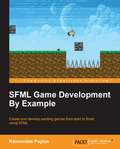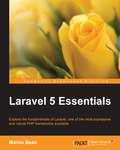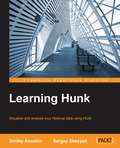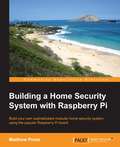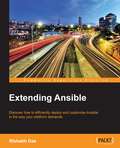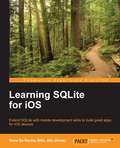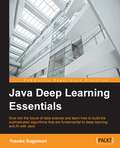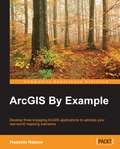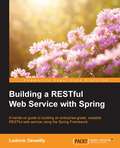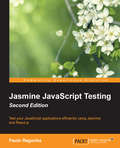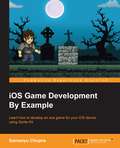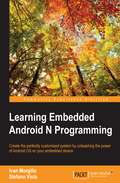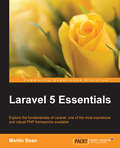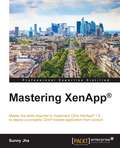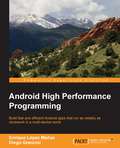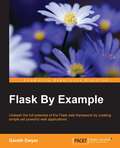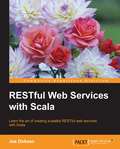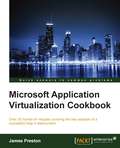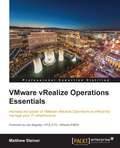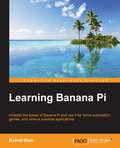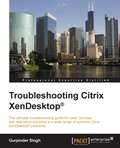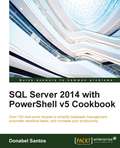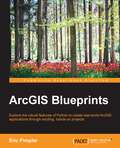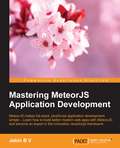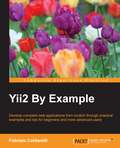- Table View
- List View
SFML Game Development By Example
by Raimondas PupiusCreate and develop exciting games from start to finish using SFML About This Book * Familiarize yourself with the SFML library and explore additional game development techniques * Craft, shape, and improve your games with SFML and common game design elements * A practical guide that will teach you how to use utilize the SFML library to build your own, fully functional applications Who This Book Is For This book is intended for game development enthusiasts with at least decent knowledge of the C++ programming language and an optional background in game design. What You Will Learn * Create and open a window by using SFML * Utilize, manage, and apply all of the features and properties of the SFML library * Employ some basic game development techniques to make your game tick * Build your own code base to make your game more robust and flexible * Apply common game development and programming patterns to solve design problems * Handle your visual and auditory resources properly * Construct a robust system for user input and interfacing * Develop and provide networking capabilities to your game In Detail Simple and Fast Multimedia Library (SFML) is a simple interface comprising five modules, namely, the audio, graphics, network, system, and window modules, which help to develop cross-platform media applications. By utilizing the SFML library, you are provided with the ability to craft games quickly and easily, without going through an extensive learning curve. This effectively serves as a confidence booster, as well as a way to delve into the game development process itself, before having to worry about more advanced topics such as "rendering pipelines" or "shaders." With just an investment of moderate C++ knowledge, this book will guide you all the way through the journey of game development. The book starts by building a clone of the classical snake game where you will learn how to open a window and render a basic sprite, write well-structured code to implement the design of the game, and use the AABB bounding box collision concept. The next game is a simple platformer with enemies, obstacles and a few different stages. Here, we will be creating states that will provide custom application flow and explore the most common yet often overlooked design patterns used in game development. Last but not the least, we will create a small RPG game where we will be using common game design patterns, multiple GUI. elements, advanced graphical features, and sounds and music features. We will also be implementing networking features that will allow other players to join and play together. By the end of the book, you will be an expert in using the SFML library to its full potential. Style and approach An elaborate take on the game development process in a way that compliments the reader's existing knowledge, this book provides plenty of examples and is kind to the uninitiated. Each chapter builds upon the knowledge gained from the previous one and offers clarifications on common issues while still remaining within the scope of its own subject and retaining clarity.
Laravel 5 Essentials
by Martin Bean<P><P>Explore the fundamentals of Laravel, one of the most expressive and robust PHP frameworks available <P><P>About This Book <P><P>Create a dynamic web application that can read and write data to a database <P><P>Improve your PHP skills and develop a new outlook on solving programming issues <P><P>A step-by-step guide that covers the different steps involved in creating a complete Laravel application in an easy-to-understand manner <P><P>Who This Book Is For <P><P>This book is intended for PHP web developers who have an interest in Laravel and who know the basics of the framework in theory, but don't really know how to use it in practice. No experience of using frameworks is required, but it is assumed you are at least familiar with building dynamic websites in PHP already. <P><P>What You Will Learn <P><P>Set up a development environment for working with Laravel apps <P><P>Create a working Laravel application from start to finish <P><P>Interact with data and discover Eloquent, Laravel's own ORM <P><P>Create and run migrations and seeds <P><P>Simplify command-line tasks by building Artisan commands <P><P>Protect your app by securing it from common security vulnerabilities <P><P>Perform end-to-end testing after learning the basics of testing in Laravel <P><P>Learn about Laravel's other features including service providers, packages, queue workers, and helpers for working with strings and arrays <P><P>In Detail <P><P>Laravel has established itself as one of the most popular PHP frameworks over the past couple of years. Its popularity comes due to its ease of use, expressive syntax, and the number of components it has, allowing you to achieve practically any task in a modern PHP application. <P><P>If you've not had the opportunity to dive into Laravel yet, then this book will be the perfect companion, as it covers the fundamentals Laravel is built on in a thorough yet easy-to-follow manner. To make this book your best learning source, we have covered integral topics such as preparing an environment for working with Laravel applications, creating your first Laravel application from start to finish, a tour of Laravel's ORM Eloquent, and more advanced topics such as testing, user authentication, and security. Being one of the most interesting features in Laravel, we also cover an overview of Artisan, including descriptions of some of its tasks. Post this, we talk about testing and security. By the end of this book, you will be able to create robust PHP websites and web applications quickly and efficiently.
Learning Hunk
by Dmitry Anoshin Sergey SheypakVisualize and analyze your Hadoop data using Hunk About This Book * Explore your data in Hadoop and NoSQL data stores * Create and optimize your reporting experience with advanced data visualizations and data analytics * A comprehensive developer's guide that helps you create outstanding analytical solutions efficiently Who This Book Is For If you are Hadoop developers who want to build efficient real-time Operation Intelligence Solutions based on Hadoop deployments or various NoSQL data stores using Hunk, this book is for you. Some familiarity with Splunk is assumed. What You Will Learn * Deploy and configure Hunk on top of Cloudera Hadoop * Create and configure Virtual Indexes for datasets * Make your data presentable using the wide variety of data visualization components and knowledge objects * Design a data model using Hunk best practices * Add more flexibility to your analytics solution via extended SDK and custom visualizations * Discover data using MongoDB as a data source * Integrate Hunk with AWS Elastic MapReduce to improve scalability In Detail Hunk is the big data analytics platform that lets you rapidly explore, analyse, and visualize data in Hadoop and NoSQL data stores. It provides a single, fluid user experience, designed to show you insights from your big data without the need for specialized skills, fixed schemas, or months of development. Hunk goes beyond typical data analysis methods and gives you the power to rapidly detect patterns and find anomalies across petabytes of raw data. This book focuses on exploring, analysing, and visualizing big data in Hadoop and NoSQL data stores with this powerful full-featured big data analytics platform. You will begin by learning the Hunk architecture and Hunk Virtual Index before moving on to how to easily analyze and visualize data using Splunk Search Language (SPL). Next you will meet Hunk Apps which can easy integrate with NoSQL data stores such as MongoDB or Sqqrl. You will also discover Hunk knowledge objects, build a semantic layer on top of Hadoop, and explore data using the friendly user-interface of Hunk Pivot. You will connect MongoDB and explore data in the data store. Finally, you will go through report acceleration techniques and analyze data in the AWS Cloud. Style and approach A step-by-step guide starting right from the basics and deep diving into the more advanced and technical aspects of Hunk.
Building a Home Security System with Raspberry Pi
by Matthew PooleBuild your own sophisticated modular home security system using the popular Raspberry Pi board About This Book * This book guides you through building a complete home security system with Raspberry Pi and helps you remotely access it from a mobile device over the Internet * It covers the fundamentals of interfacing sensors and cameras with the Raspberry Pi so that you can connect it to the outside world * It follows a modular approach so that you can choose the modules and features you want for your customized home security system Who This Book Is For This book is for anyone who is interested in building a modular home security system from scratch using a Raspberry Pi board, basic electronics, sensors, and simple scripts. This book is ideal for enthusiastic novice programmers, electronics hobbyists, and engineering professionals. It would be great if you have some basic soldering skills in order to build some of the interface modules. What You Will Learn * Understand the concepts behind alarm systems and intrusion detection devices * Connect sensors and devices to the on-board digital GPIO ports safely * Monitor and control connected devices easily using Bash shell scripting * Build an I/O port expander using the I2C bus and connect sensors and anti-tamper circuits * Capture and store images using motion detectors and cameras * Access and manage your system remotely from your mobile phone * Receive intrusion alerts and images through your e-mail * Build a sophisticated multi-zone alarm system In Detail The Raspberry Pi is a powerful low-cost credit-card-sized computer, which lends itself perfectly as the controller for a sophisticated home security system. Using the on-board interfaces available, the Raspberry Pi can be expanded to allow the connection of a virtually infinite number of security sensors and devices. The Raspberry Pi has the processing power and interfaces available to build a sophisticated home security system but at a fraction of the cost of commercially available systems. Building a Home Security System with Raspberry Pi starts off by showing you the Raspberry Pi and how to set up the Linux-based operating system. It then guides you through connecting switch sensors and LEDs to the native GPIO connector safely, and how to access them using simple Bash scripts. As you dive further in, you'll learn how to build an input/output expansion board using the I2C interface and power supply, allowing the connection of the large number of sensors needed for a typical home security setup. In the later chapters of the book, we'll look at more sophisticated topics such as adding cameras, remotely accessing the system using your mobile phone, receiving intrusion alerts and images by e-mail, and more. By the end of the book, you will be well-versed with the use of Raspberry Pi to power a home-based security system that sends message alerts whenever it is triggered and will be able to build a truly sophisticated and modular home security system. You will also gain a good understanding of Raspberry Pi's ecosystem and be able to write the functions required for a security system. Style and approach This easy-to-follow guide comprises a series of projects, where every chapter introduces a new concept and at the end of the book, all these concepts are brought together to create an entire home security system. This book features clear diagrams and code every step of the way.
Extending Ansible
by Rishabh DasDiscover how to efficiently deploy and customize Ansible in the way your platform demands About This Book * Get the first book on the market that maximizes the functionalities of Ansible * Master the skill of extending Ansible by deep diving into its modules and plugins * Work through this step-by-step guide to customizing Ansible according to your requirements Who This Book Is For This book is perfect for developers and administrators who are familiar with Ansible and Python programming, but have no knowledge of how to customize Ansible. What You Will Learn * Get a thorough understanding of Ansible modules * Find out everything about plugins that fit in the Ansible architecture * Get to grips with designing modules and handling errors * Work with data structures * Distribute Ansible extensions using PyPi and Git submodules * Get to know the various distribution methods of modules and plugins In Detail Ansible is an IT automation tool that lets you manage your Infrastructure as a Code. It helps you deploy your applications and manage configurations, thus making life easier. Ansible, in most ways, is self sufficient to address most of your requirements. Ideally, standard modules, libraries, or plugins are used to automate a given IT platform. Customizing Ansible can be done by custom module and plugin development. This book shows you how to automate most of the tasks in your IT environment, thus minimizing the need to manually perform scheduled tasks and extend your Ansible implementation by developing customized modules and plugins. You'll begin by getting an understanding of the fundamental aspects of extending the Ansible framework, such as custom functions and reusable modules. You'll then progress to building custom plugins and extensions using the fundamental building blocks explained earlier. We'll also show you how to automate some tasks using scripts. Finally, we'll demonstrate how these extensions can be seamlessly integrated into existing Ansible installations and explain how to conduct unit testing on these extensions to ensure they work as desired. Style and approach This book is a learning book on the fundamentals of Ansible framework and how it can be leveraged to extend it using the modules and plugins.
Learning SQLite for iOS
by Msc Gene Da RochaExtend SQLite with mobile development skills to build great apps for iOS devices About This Book * Implement Swift code using SQLite statements * Learn the background to SQL and SQLite for mobile development, its statements, and command features through practical examples * Extend the standard SQLite functionality and increase your software creation portfolio Who This Book Is For This book is intended for those who want to learn about SQLite and how to develop apps in Swift or HTML5 using SQLite. Whether you are an expert Objective-C programmer or new to this platform, you'll learn quickly, grasping the code in real-world apps to use Swift. What You Will Learn * Explore Swift's basic language statements * Connect to SQLite and execute SQL statements * Extend the SQLite language to create your own software extensions * Use HTML5 with Phonegap on iOS * Set up a Swift project using XCode with SQLite * Administer SQLite databases in an easy and effective way In Detail The ability to use SQLite with iOS provides a great opportunity to build amazing apps. Apple's iOS SDK provides native support for SQLite databases. This combination offers the potential to create powerful, data-persistent applications. This book starts with the architecture of SQLite database and introduces you to concepts in SQL . You will find yourself equipped to design your own database system, administer it, and maintain it. Further, you will learn how to operate your SQLite databases smoothly using SQL commands. You will be able to extend the functionality of SQLite by using its vast arsenal of C API calls to build some interesting, exciting, new, and intelligent data-driven applications. Understand how Xcode, HTML5, and Phonegap can be used to build a cross-platform modern app which can benefit from all these technologies - all through creating a complete, customizable application skeleton that you can build on for your own apps. Style and approach This book is a practical and comprehensive guide to developing applications using SQLite and iOS.
Java Deep Learning Essentials
by Yusuke SugomoriDive into the future of data science and learn how to build the sophisticated algorithms that are fundamental to deep learning and AI with Java About This Book * Go beyond the theory and put Deep Learning into practice with Java * Find out how to build a range of Deep Learning algorithms using a range of leading frameworks including DL4J, Theano and Caffe * Whether you're a data scientist or Java developer, dive in and find out how to tackle Deep Learning Who This Book Is For This book is intended for data scientists and Java developers who want to dive into the exciting world of deep learning. It would also be good for machine learning users who intend to leverage deep learning in their projects, working within a big data environment. What You Will Learn * Get a practical deep dive into machine learning and deep learning algorithms * Implement machine learning algorithms related to deep learning * Explore neural networks using some of the most popular Deep Learning frameworks * Dive into Deep Belief Nets and Stacked Denoising Autoencoders algorithms * Discover more deep learning algorithms with Dropout and Convolutional Neural Networks * Gain an insight into the deep learning library DL4J and its practical uses * Get to know device strategies to use deep learning algorithms and libraries in the real world * Explore deep learning further with Theano and Caffe In Detail AI and Deep Learning are transforming the way we understand software, making computers more intelligent than we could even imagine just a decade ago. Deep Learning algorithms are being used across a broad range of industries - as the fundamental driver of AI, being able to tackle Deep Learning is going to a vital and valuable skill not only within the tech world but also for the wider global economy that depends upon knowledge and insight for growth and success. It's something that's moving beyond the realm of data science - if you're a Java developer, this book gives you a great opportunity to expand your skillset. Starting with an introduction to basic machine learning algorithms, to give you a solid foundation, Deep Learning with Java takes you further into this vital world of stunning predictive insights and remarkable machine intelligence. Once you've got to grips with the fundamental mathematical principles, you'll start exploring neural networks and identify how to tackle challenges in large networks using advanced algorithms. You will learn how to use the DL4J library and apply Deep Learning to a range of real-world use cases. Featuring further guidance and insights to help you solve challenging problems in image processing, speech recognition, language modeling, this book will make you rethink what you can do with Java, showing you how to use it for truly cutting-edge predictive insights. As a bonus, you'll also be able to get to grips with Theano and Caffe, two of the most important tools in Deep Learning today. By the end of the book, you'll be ready to tackle Deep Learning with Java. Wherever you've come from - whether you're a data scientist or Java developer - you will become a part of the Deep Learning revolution! Style and approach This is a step-by-step, practical tutorial that discusses key concepts. This book offers a hands-on approach to key algorithms to help you develop a greater understanding of deep learning. It is packed with implementations from scratch, with detailed explanation that make the concepts easy to understand and follow.
ArcGIS By Example
by Hussein NasserDevelop three engaging ArcGIS applications to address your real-world mapping scenarios About This Book * Design, build and run ArcGIS applications using ArcObjects SDK * Extend ArcGIS objects and use add -ins to deploy applications on top of ArcGIS * An example-centric practical guide to help you understand mapping scenarios with ArcGIS Who This Book Is For If you are an application developer and wish to enhance your skills for the GIS domain with ArcGIS, then this book is for you. Previous experience with ArcGIS is not required. What You Will Learn * Use essential ArcGIS code to query geodatabases * Communicate with ArcGIS maps, with the help of critical designing and optimisation tips * Highlight and interact with objects on your map * Query ArcGIS geodatabases with related data to display your information on ArcGIS * Edit your underlying geodatabase * Explore strategies for the adaptation of various types of spatial analysis techniques into the GIS framework * Analyze tools for Geographical Information Systems and remote sensing * Experience ArcGIS's advanced tools for manipulation of shapefiles and geodatabases In Detail ArcGIS is a geographic information system (GIS) for working with maps and geographic information. It is considered the turnkey solution to creating and sharing interactive maps. ArcGIS is designed to work the way you work. With nothing to install and set up, ArcGIS helps you make your work productive from day one. The book covers the design and development of three ArcGIS applications to guide the readers in crafting their own GIS solution as per their requirements. The book begins by giving you a refresher on the concepts of ArcGIS. Without wasting any time, you'll begin with developing your first ArcGIS application. You will be developing a cell tower analysis tool. Following this, you will be guided through mapping signal strength and real - time manoeuvring in your GIS system. You will then move on to the second application of the book: a restaurant mapping system. The application will allow tourists to browse restaurants on a map, according to their preferences. Next, you will learn how to work with reviews and ratings and also cover some of the advanced searching options offered by ArcGIS. You will then make use of advanced ArcObjects to develop your third application: an excavation planning manager. The book will conclude by teaching you how work out excavation cost calculations and also saving and retrieving your excavation designs. Style and approach The book offers an enhanced way of learning ArcGIS, through the design and development of three applications throughout its length. In addition to this the book also covers features that you can add to your application as you develop each one covered in the book.
Building a RESTful Web Service with Spring
by Ludovic DewaillyA hands-on guide to building an enterprise-grade, scalable RESTful web service using the Spring Framework About This Book * Follow best practices and explore techniques such as clustering and caching to achieve a scalable web service * Leverage the Spring Framework to quickly implement RESTful endpoints * Learn to implement a client library for a RESTful web service using the Spring Framework Who This Book Is For This book is intended for those who want to learn to build RESTful web services with the Spring Framework. To make best use of the code samples included in the book, you should have a basic knowledge of the Java language. Previous experience with the Spring Framework would also help you get up and running quickly. What You Will Learn * Deep dive into the principles behind REST * Expose CRUD operations through RESTful endpoints with the Spring Framework * Devise response formats and error handling strategies, offering a consistent and flexible structure to simplify integration for service consumers * Follow the best approaches for dealing with a service's evolution while maintaining backward compatibility * Understand techniques to secure web services * Comply with the best ways to test RESTful web services, including tips for load testing * Optimise and scale web services using techniques such as caching and clustering In Detail REST is an architectural style that tackles the challenges of building scalable web services. In today's connected world, APIs have taken a central role on the web. APIs provide the fabric through which systems interact, and REST has become synonymous with APIs. The depth, breadth, and ease of use of Spring makes it one of the most attractive frameworks in the Java ecosystem. Marrying the two technologies is therefore a very natural choice. This book takes you through the design of RESTful web services and leverages the Spring Framework to implement these services. Starting from the basics of the philosophy behind REST, you'll go through the steps of designing and implementing an enterprise-grade RESTful web service. Taking a practical approach, each chapter provides code samples that you can apply to your own circumstances. This book goes beyond the use of Spring and explores approaches to tackle resilience, security, and scalability concerns. You'll learn techniques to deal with security in Spring and discover how to implement unit and integration test strategies. Finally, the book ends by walking you through building a Java client for your RESTful web service, along with some scaling techniques for it. Style and approach This book is a step-by-step, hands-on guide to designing and building RESTful web services. The book follows the natural cycle of developing these services and includes multiple code samples to help you.
Jasmine JavaScript Testing - Second Edition
by Paulo RagonhaThis book is for web developers and designers who work with React.js and JavaScript and who are new to unit testing and automation. It's assumed that you have a basic knowledge of JavaScript and HTML.
iOS Game Development By Example
by Samanyu ChopraLearn how to develop an ace game for your iOS device, using Sprite Kit About This Book * Learn about the Sprite Kit engine and create games on the iOS platform from the ground up * Acquaint your Sprite Kit knowledge with Swift programming and turn your 2D game conceptualization into reality in no time * An abridged and focused guide to develop an exhaustive mobile game Who This Book Is For This book is for beginners who want to start their game development odyssey in the iOS platform. If you are an intermediate or proficient game developer hailing from a different development platform, this book will be a perfect gateway to the Sprite Kit engine. The reader does not need to have any knowledge of Sprite Kit and building games on the iOS platform. What You Will Learn * Learn about the Sprite Kit game engine and create indie games in no time * Set sail on the quest of game development career by successfully creating a runner game * Know more about the IDE provided by Apple for game development - Xcode * Get an overview of Apple's latest programming language, Swift * Discover the functionalities of scenes and nodes in a game * Explore how physics bodies work and how to add this feature into your game * Grasp knowledge of particle effect and shaders * Add a scoring system into your game to visualize high scores In Detail Game development has always been an exciting subject for game enthusiasts and players and iOS game development takes a big piece of this cake in terms of perpetuating growth and creativity. With the newest version of iOS and Sprite Kit, comes a series of breathtaking features such as Metal rendering support, camera nodes, and a new and improved Scene Editor. Conceptualizing a game is a dream for both young and old. Sprite Kit is an exciting framework supported by Apple within the iOS development environment. With Sprite Kit, creating stunning games has become an easy avenue. Starting with the basics of game development and swift language, this book will guide you to create your own fully functional game. Dive in and learn how to build and deploy a game on your iOS platform using Sprite Kit game engine. Go on a detailed journey of game development on the iOS platform using the Sprite Kit game engine. Learn about various features implemented in iOS 8 that further increase the essence of game development using Sprite Kit. Build an endless runner game and implement features like physics bodies, character animations, scoring and other essential elements in a game. You will successfully conceive a 2D game along with discovering the path to reach the pinnacle of iOS game development. By the end of the book, you will not only have created an endless runner game but also have in-depth knowledge of creating larger games on the iOS platform. Style and approach An easy-to-follow, comprehensive guide that makes your learning experience more intriguing by gradually developing a Sprite Kit game. This book discusses each topic in detail making sure you attain a clear vision of the subject.
Learning Embedded Android N Programming
by Ivan Morgillo Stefano ViolaCreate the perfectly customized system by unleashing the power of Android OS on your embedded device About This Book * Understand the system architecture and how the source code is organized * Explore the power of Android and customize the build system * Build a fully customized Android version as per your requirements Who This Book Is For If you are a Java programmer who wants to customize, build, and deploy your own Android version using embedded programming, then this book is for you. What You Will Learn * Master Android architecture and system design * Obtain source code and understand the modular organization * Customize and build your first system image for the Android emulator * Level up and build your own Android system for a real-world device * Use Android as a home automation and entertainment system * Tailor your system with optimizations and add-ons * Reach for the stars: look at the Internet of Things, entertainment, and domotics In Detail Take a deep dive into the Android build system and its customization with Learning Embedded Android Programming, written to help you master the steep learning curve of working with embedded Android. Start by exploring the basics of Android OS, discover Google's "repo" system, and discover how to retrieve AOSP source code. You'll then find out to set up the build environment and the first AOSP system. Next, learn how to customize the boot sequence with a new animation, and use an Android "kitchen" to "cook" your custom ROM. By the end of the book, you'll be able to build customized Android open source projects by developing your own set of features. Style and approach This step-by-step guide is packed with various real-world examples to help you create a fully customized Android system with the most useful features available.
Laravel 5 Essentials
by Martin BeanThis book is intended for PHP web developers who have an interest in Laravel and who know the basics of the framework in theory, but don't really know how to use it in practice. No experience of using frameworks is required, but it is assumed you are at least familiar with building dynamic websites in PHP already.
Mastering XenApp®
by Sunny JhaMaster the skills required to implement Citrix® XenApp® 7.6 to deploy a complete Citrix®-hosted application from scratch About This Book * Learn to implement and configure components of Citrix® XenApp® 7.6, which are XenServer®, XenApp®, Citrix® License server, PVS, Storefront, Citrix® Receiver, and Netscaler to secure WAN traffic * Build the XenApp® 7.6 environment independently and perform tests to make sure the components are working as expected for internal and external traffic * Implement advanced tools in Citrix® XenApp® to build and manage a cost effective, secure, and high-performing application delivery infrastructure with this comprehensive guide Who This Book Is For This is book is for administrators who are currently managing the implemented environment and want to learn how to deploy the Citrix® Hosted virtualization solution for the application in a windows server 2012 R2 environment. A reasonable knowledge and understanding of core XenApp® elements and concepts used during virtualizing applications are assumed. What You Will Learn * Understand how to set up Hypervisor, install the management console, configure the storage repository, and create a virtual machine on hypervisor * Set up an Infrastructure component and explore ways to tune them up so that they can be used for Citrix® environment * Set up a Domain controller, DHCP, Certificate authority, and SQL server for static database for Citrix® XenApp® * Validate the Citrix® XenApp® 7.6 solution to make sure components are communicating properly * Manage the essential Citrix® components - Director, Licensing, and Policies with the Help of Citrix® studio * Optimize the behavior of an Application and share desktop via Policies * Installing and configuring Citrix® Provisioning services to deliver Citrix® XenApp® 7.6 virtual machines * Secure the external Delivery of an application and shared desktop via netscaler to enjoy mobility In Detail Citrix® XenApp® is one of the leading pieces of Application delivery software that delivers Windows compatible apps to users on any device, anywhere. Citrix® XenApp® also gives administrators the ability to manage and control the freedom of mobility by increasing the security and saving costs at the same time. This book will provide you with all the knowledge required to successfully deploy and master a complete Citrix® hosted application. First, it will cover essential concepts of the architecture of XenApp®. You will then learn how to set up Hypervisor and how to set up Infrastructure components. Next you will learn how to Set up Citrix® Components, XenApp® resources, PVS, and Netscaler. We will further look at how to prepare the environment for Rollout. Additionally, you will learn how to configure the Citrix® components such as Citrix® Director. Moreover, you'll learn about shared desktop for delivery to end users and the application of policies for effective and secure delivery. Finally, you will learn how to implement provisioning services for a Citrix® XenApp® 7.6 environment. Style and approach This book is based on a course outline and hence takes a very practical approach so you will understand how to implement the components of XenApp® in a production environment. Complemented with many best practices and troubleshooting concepts of XenApp®, this book will help you master XenApp® swiftly.
Android High Performance Programming
by Diego Grancini Enrique Lopez ManasBuild fast and efficient Android apps that run as reliably as clockwork in a multi-device world About This Book * Wide coverage of various topics that help in developing optimal applications * Explore the concepts of Advanced Native Coding in depth * A must-have for professional-standard Android developers for whom performance failures and the sloppy use of resources are simply unacceptable Who This Book Is For This book is aimed at developers with an advanced knowledge of Android and who want to test their skills and learn new techniques to increase the performance of their applications. We assume they are comfortable working with the entire Android SDK, and have been doing it for a few years. They need to be familiar with frameworks such as NDK to use native code, which is crucial for app performance What You Will Learn * Create Android applications that squeeze the most from the limited resource capacity of devices * Swap code that isn't performing * Efficient memory management by identifying problems such as leaks * Reap the benefits of multithreaded and asynchronous programming * Maximize the security and encryption mechanisms natively provided by Android * Perform efficient network operations and techniques to retrieve data from servers * Master the NDK to write native code that can perform faster operations In Detail Performant applications are one of the key drivers of success in the mobile world. Users may abandon an app if it runs slowly. Learning how to build applications that balance speed and performance with functionality and UX can be a challenge; however, it's now more important than ever to get that balance right. Android High Performance will start you thinking about how to wring the most from any hardware your app is installed on, so you can increase your reach and engagement. The book begins by providing an introduction to state-of-the-art Android techniques and the importance of performance in an Android application. Then, we will explain the Android SDK tools regularly used to debug and profile Android applications. We will also learn about some advanced topics such as building layouts, multithreading, networking, and security. Battery life is one of the biggest bottlenecks in applications; and this book will show typical examples of code that exhausts battery life, how to prevent this, and how to measure battery consumption from an application in every kind of situation to ensure your apps don't drain more than they should. This book explains techniques for building optimized and efficient systems that do not drain the battery, cause memory leaks, or slow down with time. Style and approach The book follows a tutorial-based approach to take the reader from the basic fundamentals of debugging to advanced performance-improvement concepts.
Flask By Example
by Gareth DwyerUnleash the full potential of the Flask web framework by creating simple yet powerful web applications About This Book * The most up-to-date book on Flask on the market * Create your own world-class applications and master the art of Flask by unravelling its enigma through this journey * This step-by-step tutorial is packed with examples on blending different technologies with Flask to get you up and running Who This Book Is For Have you looked at PHP and hated the clunky bloated syntax? Or looked at .Net and wished it was more open and flexible? Maybe you've tried your hand at GUI libraries in Python and found them hard to use? If your answer to any one of these questions is a yes, then this is just the book for you. It is also intended for people who know the basics of Python and want to learn how to use it to build powerful solutions with a web front-end. What You Will Learn * Build three web applications from the ground up using the powerful Python micro framework, Flask. * Dynamically display data to your viewers, based on their requests * Store user and static data in SQL and NoSQL databases and use this data to power your web applications * Create a good user experience by combining HTML, CSS, and JavaScript * Harness the convenience of freely available APIs, including OpenWeatherMap, Open Exchange Rates, and bitly * Extend your applications to build advanced functionality, such as a user account control system using Flask-Login * Learn about web application security and defend against common attacks, such as SQL injection and XSS In Detail This book will take you on a journey from learning about web development using Flask to building fully functional web applications. In the first major project, we develop a dynamic Headlines application that displays the latest news headlines along with up-to-date currency and weather information. In project two, we build a Crime Map application that is backed by a MySQL database, allowing users to submit information on and the location of crimes in order to plot danger zones and other crime trends within an area. In the final project, we combine Flask with more modern technologies, such as Twitter's Bootstrap and the NoSQL database MongoDB, to create a Waiter Caller application that allows restaurant patrons to easily call a waiter to their table. This pragmatic tutorial will keep you engaged as you learn the crux of Flask by working on challenging real-world applications. Style and approach This book will provide you with rich, practical experience of Flask. Every technology, that is employed along with Flask is comprehensively introduced, while the book focusses on developing web applications. Pointers to educational material are always given if you want to gain in-depth knowledge of the various technologies used.
RESTful Web Services with Scala
by Jos DirksenLearn the art of creating scalable RESTful web services with Scala About This Book * This is the only book on the market that will help you create scalable RESTful web services using five popular Scala-based REST frameworks * Quickly identify the best framework for a specific problem and select the most appropriate solution to suit your requirements * This practical guide will help you implement a complete REST-based API from scratch Who This Book Is For If you are a Scala developer with some Scala experience and you want to get an overview of the frameworks that are available in the Scala world, then this book is perfect for you. You need to have a general knowledge of REST and Scala. This book is great for senior Scala (or other language) developers who are looking for a good REST framework to use together with Scala. What You Will Learn * Set up a development environment to easily develop and test REST services * Discover the different ways in which you can create REST services with Scala * See and explore the different approaches taken by popular REST frameworks * Get to know more about a variety of available Scala frameworks such as Finch, Unfiltered, Scalatra, Akka-HTTP, and Play * Discover how to create a REST service on top of each framework discussed in this book * Create HTTP clients using the frameworks in this book * Make an informed decision about which framework to use in a specific situation * Set up authentication for your REST services In Detail RESTful web services are built to work best on the web. Scala provides a rich set of language constructs and advanced frameworks that you can use to create REST services. However, using Scala and these tools can be a complex task. There are many frameworks available and choosing the wrong framework or approach can cost a lot of time and lead to much frustration. By exploring the most popular Scala REST frameworks, you can make sure you choose the right tool. RESTful Web Services with Scala begins with a brief explanation of the REST architecture and its implementation in Scala, as well as the impact that REST architecture has on Scala applications. You will understand the advantages of building Scala web services and how existing Scala applications can take advantage of REST. This book will teach developers about the different programming paradigms available in the Scala world to create RESTful services by exploring the most popular Scala-oriented REST frameworks. It discusses the various facets of RESTful web services such as building scalable APIs, working with standards like HTTP and MIME, designing the architecture, securing the web service, and more. With this book, you will be able to build RESTful web services with various Scala frameworks such as Finch, Unfiltered, Scalatra, Akka-HTTP, and Play. You will create basic REST services using frameworks and then extend the REST services with custom functionality. By the end of the book, you'll be able to decide which framework is best suited for your requirements. We finish by looking at how we can use a number of advanced features provided by these frameworks, such as security, creating HTTP clients, working with HATEOAS, and more. Style and approach This book follows a practical approach where we implement a REST API using each of the frameworks discussed. This book is filled with rich examples and code so you can understand and implement the features of every framework.
Microsoft Application Virtualization Cookbook
by James PrestonIf you have some experience with App-V but are overwhelmed by the range of features on offer, then this book is for you. A basic understanding of App-V and common Windows Server technologies (Active Directory/Group Policy/PowerShell) is necessary.
VMware vRealize Operations Essentials
by Matthew SteinerHarness the power of VMware vRealize Operations to efficiently manage your IT infrastructure About This Book * Extract the optimum performance, availability, and capacity of your IT infrastructure with the help of vRealise Operations Manager * Leverage the power of strategic reports to drive tactful decision-making within the IT department * A pragmatic guide to proficiently manage your applications and storage Who This Book Is For If you are a vSphere administrator and wish to optimize your virtual environment, this book is your go-to guide on vRealize Operations. As a vSphere administrator, it is assumed that you have a good understanding of both physical and virtual infrastructure. A basic knowledge of application monitoring and log analysis would be useful when we dive into the capabilities of the solution. What You Will Learn * Architect, design, and install vRealize Operations * Migrate from the previous vCenter Operations Manager 5.x version, configure vR Ops policies, and create custom groups * Use out-of-the-box Dashboards, Views, and Reports and create your own customized Dashboards, Views, and Reports * Apply the Alerting framework of Symptoms, Recommendations, and Actions, and create your own Alerting content * Leverage the power of Capacity Planning to maximize the utilization of your virtual infrastructure * Manage the rest of your infrastructure, including storage and applications, with vRealize Operations Management Packs * Extend the solution with vRealize Hyperic and Log Insight In Detail This book will enable you to deliver on the operational disciplines of Performance, Health, Capacity, Configuration, and Compliance by making the best use of solutions provided by vRealize Operations. Starting with architecture, design, and sizing, we will ensure your implementation of vRealize Operations is a success. We will dive into the utilization of a solution to manage your vSphere infrastructure. Then, we will employ out-of-the-box Dashboards and the very powerful Views and Reporting functionality of vRealize Operations to create your custom dashboards and address your reporting requirements. Next, we go through the Alerting framework and how Symptoms, Recommendations, and Actions are used to achieve efficient operations. Later you will master the topic of Capacity Planning, where we look at how important it is to craft appropriate policies to match your requirements, and we'll consider attitude toward capacity risk, which will aid you to build future project requirements into your capacity plans. Finally, we will look at extending the solution to manage Storage, Applications, and other IT infrastructures using Management Packs from Solution Exchange, as well as how the solution can be enhanced with the integration of Log Insight. Style and approach This book is a pragmatic, step-by-step guide that will quickly build your knowledge of the key capabilities of vRealize Operations. As well as learning about the solution, we will provide you with real-world examples that will help you customize and enhance your virtual environment.
Learning Banana Pi
by Daniel BlairThis book is for anyone who wants to explore Banana Pi and get started building projects on their own using it. No prior experience of working with single board computers is required.
Troubleshooting Citrix XenDesktop®
by Gurpinder SinghThe ultimate troubleshooting guide for clear, concise, and real-world solutions to a wide range of common Citrix XenDesktop problemsAbout This BookExplore the XenDesktop architecture and work with various troubleshooting tools that every Citrix admin should know aboutDiscover how to troubleshoot performance, VDA registration, and NetScaler integration issuesA fast-paced troubleshooting guide to help you identify and resolve any kind of problem you might face while working with Citrix XenDesktopWho This Book Is ForTroubleshooting Citrix XenDesktop is targeted at Citrix Administrators or Citrix Engineers who are working on Xendesktop and want to learn tips and techniques required to deal with the issues they face in their day-to-day life. A working knowledge of core elements and concepts of Xendesktop would be an added advantage.What You Will LearnSolve VDA registration problems and Citrix session launch difficultiesIdentify and resolve XenDesktop service issuesTroubleshoot performance issues related to the XenDesktop architectureWork around common printing issuesUnderstand the Citrix XenDesktop HDX policies and deal with the HDX MediaStream challengesResolve the common MCS and PVS configuration issues in your XenDesktop environmentFind solutions to some general issues that have been identified and recorded by Citrix in their database that every administrator must be aware ofIn DetailIn today's world, many organizations have decided to move to secure and stable VDI platforms to benefit their organization to meet their security needs. To meet an organization's requirements, Citrix XenDesktop serves as the best desktop virtualization solution available, providing the optimum user experience.Troubleshooting Citrix XenDesktop is a single resource guide that will help you dig deep into all the technical issues you encounter to resolve them using an autonomous and well-defined approach.The book starts by walking you through the XenDesktop architecture and the troubleshooting toolkit for Citrix XenDesktop. The subsequent chapters will help you identify possible causes of various types of Citrix XenDesktop problems that may arise while installing, configuring, or troubleshooting day-to-day problems. You will also be dealing with the most common and important VDA registration problems that you might often face while working with the XenDesktop product suite. Additionally, you will resolve issues that arise while launching Citrix sessions, troubleshoot performance issues, and learn how to integrate Citrix NetScaler with your XenDesktop environment.Style and approachThis book is an easy-to-follow troubleshooting guide with real-world examples of resolving XenDesktop issues. Each chapter is focused on a specific troubleshooting area, giving you the time to learn about and apply relevant tools and practices to troubleshoot the problems using a systematic approach.
SQL Server 2012 with PowerShell V3 Cookbook
by Donabel SantosSQL Server 2012 with PowerShell V3 Cookbook" is an example-focused book that provides step-by-step instructions on how to accomplish specific SQL Server tasks using PowerShell. Each recipe is followed by an analysis of the steps or design decisions taken, and additional information about the task at hand. Working scripts are provided for all examples so that you can dive in right away. You can read this book sequentially by chapter, or you can pick and choose which topics you need right away,This book is written for the SQL Server database professional (DBA, developer, BI developer) who wants to use PowerShell to automate, integrate, and simplify database tasks. A little bit of scripting background is helpful, but not necessary.
ArcGIS Blueprints
by Eric PimplerExplore the robust features of Python to create real-world ArcGIS applications through exciting, hands-on projects About This Book * Get to grips with the big world of Python add-ins and wxPython in GUI development to implement their features in your application * Integrate advanced Python libraries, ArcPy mapping, and data access module techniques to develop a mapping application * Construct a top-notch intermediate-to-advanced project by accessing ArcGIS Server and ArcGIS Online resources through the ArcGIS REST API using a project-based approach Who This Book Is For If you have prior experience building simple apps with ArcGIS and now have a fancy for developing a more challenging and complex desktop application in ArcGIS, then this book is ideal for you. What You Will Learn * Automate the creation of creative output data visualizations including maps, charts, and graphs * Explore ways to use the ArcPy Mapping module and Data-driven Pages to automate the creation of map books in your own project * Develop applications that use the Plotly platform and library to create stunning charts and graphs that can be integrated into ArcGIS Desktop * Build tools that access REST services and download data to a local geodatabase * Design, build, and integrate advanced GUIs with wxPython and ArcGIS Desktop in ArcGIS * Get clued up about constructing applications that export data to Google Earth Pro to automate time-consuming complex processes * Maximize the access of ArcGIS Server and ArcGIS Online using the ArcGIS REST API with Python In Detail This book is an immersive guide to take your ArcGIS Desktop application development skills to the next level It starts off by providing detailed description and examples of how to create ArcGIS Desktop Python toolboxes that will serve as containers for many of the applications that you will build. We provide several practical projects that involve building a local area/community map and extracting wildfire data. You will then learn how to build tools that can access data from ArcGIS Server using the ArcGIS REST API. Furthermore, we deal with the integration of additional open source Python libraries into your applications, which will help you chart and graph advanced GUI development; read and write JSON, CSV, and XML format data sources; write outputs to Google Earth Pro, and more. Along the way, you will be introduced to advanced ArcPy Mapping and ArcPy Data Access module techniques and use data-driven Pages to automate the creation of map books. Finally, you will learn advanced techniques to work with video and social media feeds. By the end of the book, you will have your own desktop application without having spent too much time learning sophisticated theory. Style and approach This is an easy-to-follow, project-based guide that guides you through the whole ArcGIS theme with practical, real-world examples and a systematic approach.
Mastering MeteorJS Application Development
by Jebin B VMeteorJS makes full-stack JavaScript Application Development simple - Learn how to build better modern web apps with MeteorJS, and become an expert in the innovative JavaScript framework About This Book * Get your dream project up and running by building exceptional MeteorJS applications in a matter of days * Learn how to integrate other JavaScript frameworks into your MeteorJS project and become an expert in full-stack development * Go beyond coding and learn how to make modern design decisions - from mobile design to SEO - that drive great user experiences Who This Book Is For If you've already had some experience with MeteorJS but want to learn how to build even better modern web application, this book has been created for you. It provides you with a comprehensive look at one of those most important frameworks being used for the modern web today. What You Will Learn * Get to grips with the basics and learn how to build a complete real-time application with MeteorJS * Find out how Meteor makes full-stack development simple - become a better developer, fast. * Use some of the most effective testing tools in modern web development to troubleshoot, debug and optimize your app * Find out how to write custom packages for applications - so you can build your project exactly how you want * Integrate React and Angular into your project * Design and develop high quality animations that will give your UI the edge * Build MeteorJS to serve as REST-based application and reactive system * Learn how to host a MeteorJS application and then scale it for data * Find out how MeteorJS can help you build for mobile * Learn how to make sure you implement an effective SEO strategy in your MeteorJS application In Detail The web is dead - applications now rule our online experiences. But how are you going to build them? Well, if you've been paying attention, you might already have tried your hand with MeteorJS, the JavaScript framework that helps you build complete full-stack web applications that are responsive and fast with ease. Mastering MeteorJS Application Development shows you how to do even more with MeteorJS - if you're ready to try a comprehensive course through one of the most exciting frameworks in web development today, this is the book you need. Designed to take you through the entire process of building an advanced multipage application with Meteor, you'll be able to bring your web development ideas with surprising ease. You'll not only learn how Meteor makes web development easier, but also how you can make using Meteor easier, by automating and simplifying tasks so you can be confident you have full control of everything in your workflow - especially everything that could go wrong. From automated testing to integrating other useful frameworks such as Angular and D3, each chapter covers a crucial element in the Meteor development process. Discover how to integrate animations using Meteor's Blaze, to give your UI designs the edge, and explore reactive programming to effectively harness RESTful systems in your projects. You will also learn how to deploy and scale your application, two crucial aspects of modern development and vital in a changing digital environment with users expecting a product and experience that delivers. With further insights on developing for mobile - and how Meteor can help you tackle the challenges of the trend - and details on incorporating SEO strategies into your application, this book isn't just a code tutorial - it's about creating a product that users love. Style and approach This book is a practical guide that teaches you different ways to create custom packages, efficient client and server code, and more using Meteor. This book is packed with perfect examples and explanations to help you understand the concepts. With the perfect mix of theory and practical experience, it will equip you to become a professional MeteorJS developer.
Yii2 By Example
by Fabrizio CaldarelliDevelop complete web applications from scratch through practical examples and tips for beginners and more advanced users About This Book * Improve your programming experience and become a full stack developer * Master real-life web applications, and create and manage four different projects * Step-by-step guidance to develop real-world web applications smoothly Who This Book Is For This book is for anyone who wants to discover and explore Yii Framework. Basic programming experience with PHP and object oriented programming is assumed. What You Will Learn * Understand basic concepts, along with the installation and customization of Yii * Discover models, controllers, and views--concepts applied in a web context--and how they are employed in Yii * Use ActiveRecord to manipulate a database * Add access control to your web application through authentication and authorization * Install and customize an advanced template for multiple applications in the same project * Create a RESTful Web Service to allow remote access to data * Develop a console application to launch a command in the console as an automated task (cron job) * Make code reusable through widgets and components and localize text messages to make a multilanguage web app In Detail Yii is a high-performance PHP framework best for developing Web 2.0 applications. It provides fast, secure, and professional features to create robust projects, however, this rapid development requires the ability to organize common tasks together to build a complete application. It's all too easy to get confused; this is where this book comes in. This book contains a series of practical project examples for developers starting from scratch. Each section contains the most relevant theories for every topic as you walk through developing each project, focusing on key aspects that commonly confuse users. The book starts with all the framework's basic concepts, such as controllers and views, to introduce you to Yii and creating your first application, a simple news reader. You will be learn to configure URL rules to make a pretty URL, essential for search engine optimization. Next, you will walk through Model and ActiveRecord, key concepts in database interaction. The second application you will develop is a reservation system that allows you to manage rooms, customers, and reservations. For this, you will use database connection through SQL and ActiveRecord. More complex than the first one, this application will introduce you to the advanced template of Yii 2, splitting the app into two parts: a frontend for all visitors and a backend for the admin. Finally, you will move on to the last two applications: one that allows connections from remote clients, through RESTful components of Yii 2, and another that creates and organizes automatic tasks using the console application structure of Yii 2. Style and approach This is a step-by-step guide with each topic introduced in the context of real-world applications, highlighting common cases where users may encounter difficulties.
